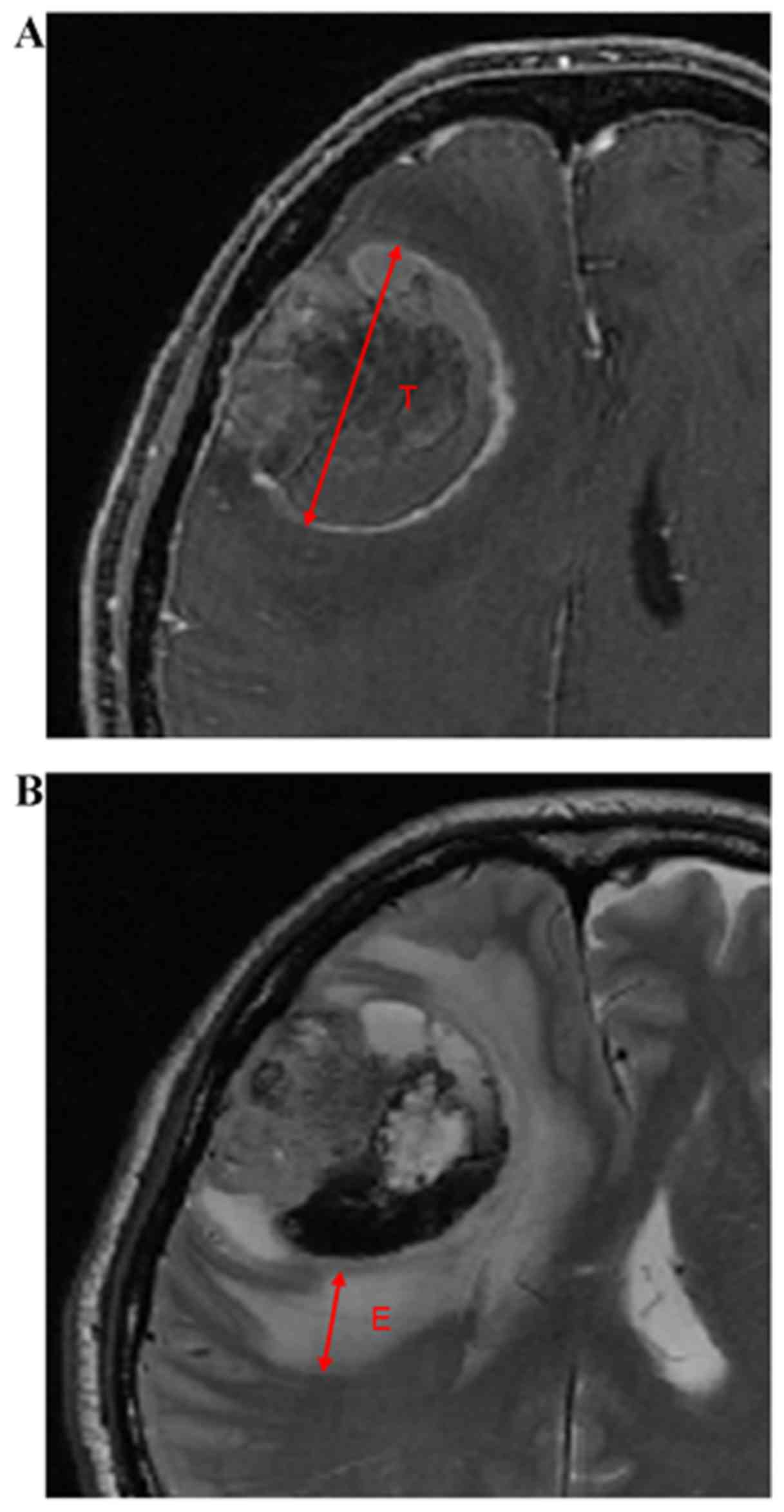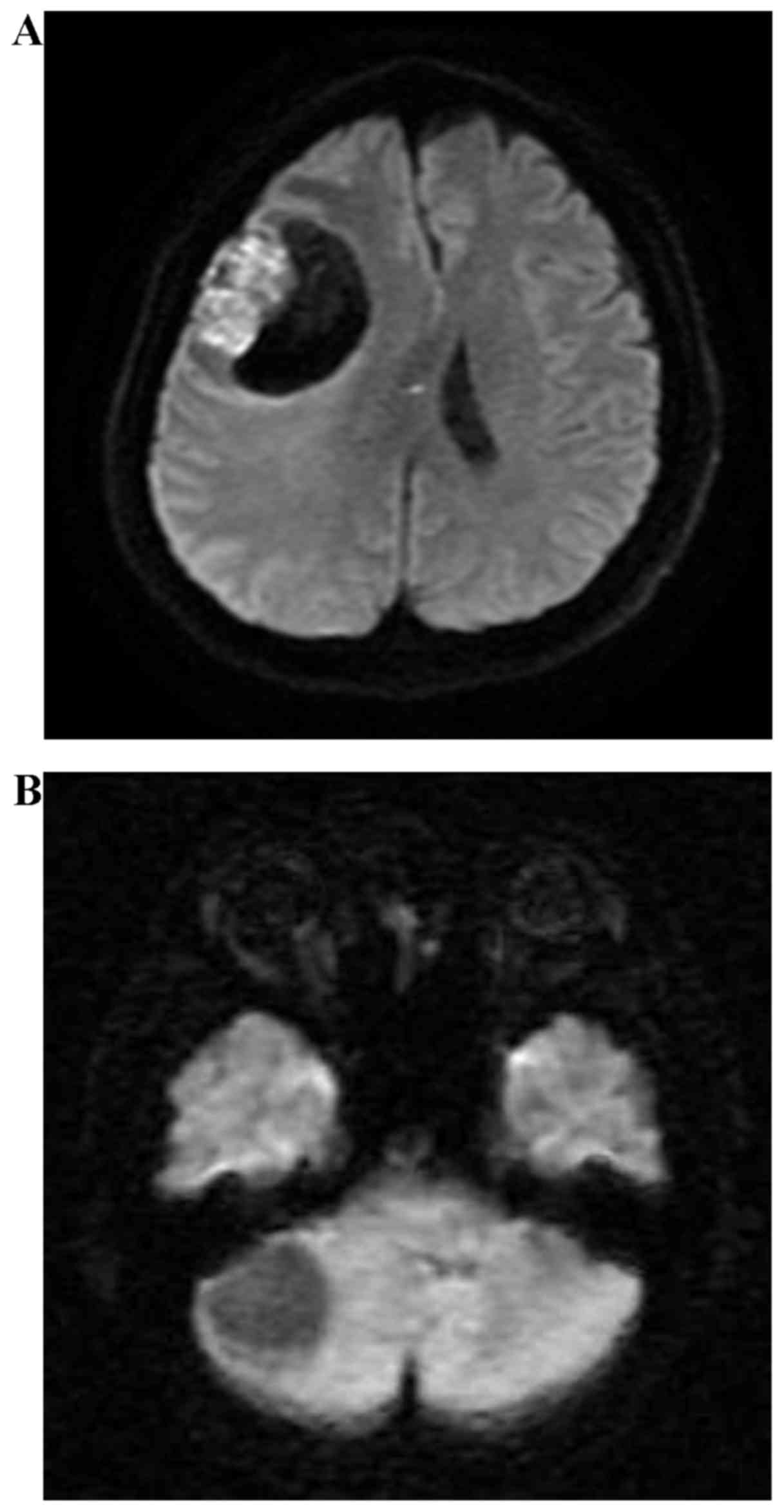|
1
|
Gaspar L, Scott C, Rotman M, Asbell S,
Phillips T, Wasserman T, McKenna WG and Byhardt R: Recursive
partitioning analysis (RPA) of prognostic factors in three
Radiation therapy oncology group (RTOG) brain metastases trials.
Int J Radiat Oncol Biol Phys. 37:745–751. 1997. View Article : Google Scholar : PubMed/NCBI
|
|
2
|
Lagerwaard FJ, Levendag PC, Nowak PJ,
Eijkenboom WM, Hanssens PE and Schmitz PI: Identification of
prognostic factors in patients with brain metastases: A review of
1292 patients. Int J Radiat Oncol Biol Phys. 43:795–803. 1999.
View Article : Google Scholar : PubMed/NCBI
|
|
3
|
Gaspar LE, Mehta MP, Patchell RA, Burri
SH, Robinson PD, Morris RE, Ammirati M, Andrews DW, Asher AL, Cobbs
CS, et al: The role of whole brain radiation therapy in the
management of newly diagnosed brain metastases: A systematic review
and evidence-based clinical practice guideline. J Neurooncol.
96:17–32. 2010. View Article : Google Scholar : PubMed/NCBI
|
|
4
|
Postmus PE, Haaxma-Reiche H, Gregor A,
Groen HJ, Lewinski T and Scolard T: Brain-only metastases of small
cell lung cancer; efficacy of whole brain radiotherapy. An EORTC
phase II study. Radiother Oncol. 46:29–32. 1998. View Article : Google Scholar : PubMed/NCBI
|
|
5
|
Gao Y, Gao F, Ma JL and Zhao DL:
Palliative whole-brain radiotherapy and health-related quality of
life for patients with brain metastasis in cancer. Neuropsychiatr
Dis Treat. 11:2185–2190. 2015. View Article : Google Scholar : PubMed/NCBI
|
|
6
|
Chao JH, Phillips R and Nickson JJ:
Roentgen-ray therapy of cerebral metastases. Cancer. 7:682–689.
1954. View Article : Google Scholar : PubMed/NCBI
|
|
7
|
Order SE, Hellman S, Von Essen CF and
Kligerman MM: Improvement in quality of survival following
whole-brain irradiation for brain metastases. Radiology.
91:149–153. 1968. View
Article : Google Scholar : PubMed/NCBI
|
|
8
|
Tsao MN, Lloyd NS, Wong RK, Rakovitch E,
Chow E and Laperriere N: Supportive Care Guidelines Group of Cancer
Care Ontario's Program in Evidence-based Care: Radiotherapeutic
management of brain metastases: A systematic review and
meta-analysis. Cancer Treat Rev. 31:256–273. 2005. View Article : Google Scholar : PubMed/NCBI
|
|
9
|
Zimmermann S, Dziadziuszko R and Peters S:
Indications and limitations of chemotherapy and targeted agents in
non-small cell lung cancer brain metastases. Cancer Treat Rev.
40:716–722. 2014. View Article : Google Scholar : PubMed/NCBI
|
|
10
|
Niibe Y, Karasawa K, Nakamura O, Shinoura
N, Okamoto K, Yamada R, Fukino K and Tanaka Y: Survival benefit of
stereotactic radiosurgery for metastatic brain tumors in patients
with controlled primary lesions and no other distant metastases.
Anticancer Res. 23:4157–4159. 2003.PubMed/NCBI
|
|
11
|
Hellman S and Weichselbaum RR:
Oligometastases. J Clin Oncol. 13:8–10. 1995. View Article : Google Scholar : PubMed/NCBI
|
|
12
|
Niibe Y and Hayakawa K: Oligometastases
and oligo-recurrence: The new era of cancer therapy. Jpn J Clin
Oncol. 40:107–111. 2010. View Article : Google Scholar : PubMed/NCBI
|
|
13
|
Niibe Y and Chang JY: Novel insights of
oligometastases and oligo-recurrence and review of the literature.
Pulm Med. 2012:2610962012. View Article : Google Scholar : PubMed/NCBI
|
|
14
|
Niibe Y, Chang JY, Onishi H, Salama J,
Hiraki T and Yamashita H: Oligometastases/Oligo-recurrence of lung
cancer. Pulm Med. 2013:4382362013. View Article : Google Scholar : PubMed/NCBI
|
|
15
|
Yamashita H, Niibe Y, Yamamoto T, Katsui
K, Jingu K, Kanazawa S, Terahara A and Nakagawa K: Lung
stereotactic radiotherapy for oligometastases: Comparison of
oligo-recurrence and sync oligometastases. Jpn J Clin Oncol.
46:687–791. 2016. View Article : Google Scholar : PubMed/NCBI
|
|
16
|
Won YK, Lee JY, Kang YN, Jang JS, Kang JH,
Jung SL, Sung SY, Jo IY, Park HH, Lee DS, et al: Stereotactic
radiosurgery for brain metastasis in non-small cell lung cancer.
Radiat Oncol J. 33:207–216. 2015. View Article : Google Scholar : PubMed/NCBI
|
|
17
|
Wang TJ, Saad S, Qureshi YH, Jani A,
Isaacson SR, Sisti MB, Bruce JN, McKhann GM II, Lesser J, Cheng SK,
et al: Outcomes of gamma knife radiosurgery, bi-modality &
tri-modality treatment regimens for patients with one or multiple
brain metastases: The Columbia University Medical Center
experience. J Neurooncol. 122:399–408. 2015. View Article : Google Scholar : PubMed/NCBI
|
|
18
|
Niibe Y, Nishimura T, Inoue T, Karasawa
KY, Jingu K and Shirato H: Oligo-recurrence predicts favorable
prognosis of brain-only oligometastases in patients with non-small
cell lung cancer treated with stereotactic radiosurgery or
stereotactic radiotherapy: A multi-institutional study of 61
subjects. BMC Cancer. 16:6592016. View Article : Google Scholar : PubMed/NCBI
|
|
19
|
Mulvenna PM: The management of brain
metastases in patients with non-small cell lung cancer-is it time
to go back to the drawing board? Clin Oncol (R Coll Radiol).
22:365–373. 2010. View Article : Google Scholar : PubMed/NCBI
|
|
20
|
Partl R, Fastner G, Kaiser J, Kronhuber E,
Cetin-Strohmer K, Steffal C, Böhmer-Breitfelder B, Mayer J, Avian A
and Berghold A: KPS/LDH index: A simple tool for identifying
patients with metastatic melanoma who are unlikely to benefit from
palliative whole brain radiotherapy. Support Care Cancer.
24:523–528. 2016. View Article : Google Scholar : PubMed/NCBI
|
|
21
|
Windsor AA, Koh ES, Allen S, Gabriel GS,
Yeo AE, Allison R, van der Linden YM and Barton MB: Poor outcomes
after whole brain radiotherapy in patients with brain metastases:
Results from an international multicentre cohort study. Clin Oncol
(R Coll Radiol). 25:674–680. 2013. View Article : Google Scholar : PubMed/NCBI
|
|
22
|
Rades D, Dziggel L, Nagy V, Segedin B,
Lohynska R, Veninga T, Khoa MT, Trang NT and Schild SE: A new
survival score for patients with brain metastases who received
whole-brain radiotherapy (WBRT) alone. Radiother Oncol.
108:123–127. 2013. View Article : Google Scholar : PubMed/NCBI
|
|
23
|
Zimm S, Wampler GL, Stablein D, Hazra T
and Young HF: Intracerebral metastases in solid-tumor patients:
Natural history and results of treatment. Cancer. 48:384–394. 1981.
View Article : Google Scholar : PubMed/NCBI
|
|
24
|
Sperduto PW, Berkey B, Gaspar LE, Mehta M
and Curran W: A new prognostic index and comparison to three other
indices for patients with brain metastases: An analysis of 1,960
patients in the RTOG database. Int J Radiat Oncol Biol Phys.
70:510–514. 2008. View Article : Google Scholar : PubMed/NCBI
|
|
25
|
Komatsu T, Kunieda E, Oizumi Y, Tamai Y
and Akiba T: Clinical characteristics of brain metastases from lung
cancer according to histological type: Pretreatment evaluation and
survival following whole-brain radiotherapy. Mol Clin Oncol.
1:692–698. 2013.PubMed/NCBI
|
|
26
|
Mayahara H, Sumi M, Ito Y, Sekii S,
Takahashi K, Inaba K, Kuroda Y, Murakami N, Morota M and Itami J:
Effect of chemotherapy on survival after whole brain radiation
therapy for brain metastases: A single-center retrospective
analysis. J Cancer Res Clin Oncol. 138:1239–1247. 2012. View Article : Google Scholar : PubMed/NCBI
|
|
27
|
Zhu JF, Cai L, Zhang XW, Wen YS, Su XD,
Rong TH and Zhang LJ: High plasma fibrinogen concentration and
platelet count unfavorably impact survival in non-small cell lung
cancer patients with brain metastases. Chin J Cancer. 33:96–104.
2014. View Article : Google Scholar : PubMed/NCBI
|
|
28
|
Barnes EA, Chow E, Tsao MN, Bradley NM,
Doyle M, Li K, Lam K and Danjoux C: Physician expectations of
treatment outcomes for patients with brain metastases referred for
whole brain radiotherapy. Int J Radiat Oncol Biol Phys. 76:187–192.
2010. View Article : Google Scholar : PubMed/NCBI
|
|
29
|
Kuremsky JG, Urbanic JJ, Petty WJ, Lovato
JF, Bourland JD, Tatter SB, Ellis TL, McMullen KP, Shaw EG and Chan
MD: Tumor histology predicts patterns of failure and survival in
patients with brain metastases from lung cancer treated with gamma
knife radiosurgery. Neurosurgery. 73:641–647. 2013. View Article : Google Scholar : PubMed/NCBI
|
|
30
|
Seute T, Leffers P, Wilmink JT, ten Velde
GP and Twijnstra A: Response of asymptomatic brain metastases from
small-cell lung cancer to systemic first-line chemotherapy. J Clin
Oncol. 24:2079–2083. 2006. View Article : Google Scholar : PubMed/NCBI
|
|
31
|
Bohlen G, Meyners T, Kieckebusch S,
Lohynska R, Veninga T, Stalpers LJ, Schild SE and Rades D:
Short-course whole-brain radiotherapy (WBRT) for brain metastases
due to small-cell lung cancer (SCLC). Clin Neurol Neurosurg.
112:183–187. 2010. View Article : Google Scholar : PubMed/NCBI
|
|
32
|
Schuette W: Treatment of brain metastases
from lung cancer: Chemotherapy. Lung Cancer. 45 Suppl 2:S253–S257.
2004. View Article : Google Scholar : PubMed/NCBI
|
|
33
|
Zhang M and Olsson Y: Hematogenous
metastases of the human brain-characteristics of peritumoral brain
changes: A review. J Neurooncol. 35:81–89. 1997. View Article : Google Scholar : PubMed/NCBI
|
|
34
|
Wang L, Han C, Zhu S, Shi G, Wang Q, Tian
H, Kong J and Zhang A: Investigation of using diffusion-weighted
magnetic resonance imaging to evaluate the therapeutic effect of
esophageal carcinoma treatment. Oncol Res Treat. 37:112–116. 2014.
View Article : Google Scholar : PubMed/NCBI
|
|
35
|
Chen Y, Liu X, Zheng D, Xu L, Hong L, Xu Y
and Pan J: Diffusion-weighted magnetic resonance imaging for early
response assessment of chemoradiotherapy in patients with
nasopharyngeal carcinoma. Magn Reson Imaging. 32:630–637. 2014.
View Article : Google Scholar : PubMed/NCBI
|
|
36
|
Hong J, Yao Y, Zhang Y, Tang T, Zhang H,
Bao D, Chen Y and Pan J: Value of magnetic resonance
diffusion-weighted imaging for the prediction of radiosensitivity
in nasopharyngeal carcinoma. Otolaryngol Head Neck Surg.
149:707–713. 2013. View Article : Google Scholar : PubMed/NCBI
|
|
37
|
Mardor Y, Roth Y, Ochershvilli A,
Spiegelmann R, Tichler T, Daniels D, Maier SE, Nissim O, Ram Z,
Baram J, et al: Pretreatment prediction of brain tumors' response
to radiation therapy using high b-value diffusion-weighted MRI.
Neoplasia. 6:136–142. 2004. View Article : Google Scholar : PubMed/NCBI
|
|
38
|
Lee CC, Wintermark M, Xu Z, Yen CP,
Schlesinger D and Sheehan JP: Application of diffusion-weighted
magnetic resonance imaging to predict the intracranial metastatic
tumor response to gamma knife radiosurgery. J Neurooncol.
118:351–361. 2014. View Article : Google Scholar : PubMed/NCBI
|
|
39
|
Osborn AG: Osborn's Brain: Imaging,
Pathology and Anatomy. Lippincott Williams & Wilkins;
Philadelphia, PA: 2012
|
|
40
|
Tsao MN, Rades D, Wirth A, Lo SS,
Danielson BL, Gaspar LE, Sperduto PW, Vogelbaum MA, Radawski JD,
Wang JZ, et al: Radiotherapeutic and surgical management for newly
diagnosed brain metastasis(es): An American Society for Radiation
Oncology evidence-based guideline. Pract Radiat Oncol. 2:210–225.
2012. View Article : Google Scholar : PubMed/NCBI
|
















